英美文化 Chapter1
英美文化入门
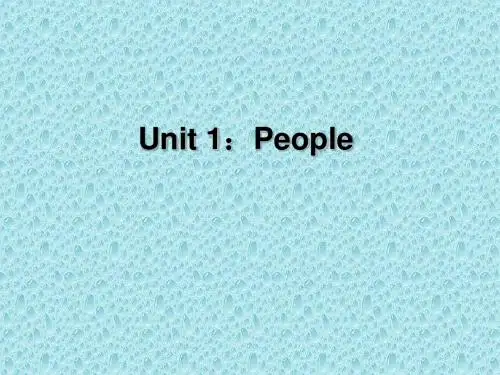
The Archbishop of York
IV. Teaching Hours
V. Contents
1.Ethnic composition
1)Before the Norman Conquest
• • • • • • • Iberians Celts Angles Saxons Jutes Scandinavians French Normans
V. Contents
2. A Brief Introduction of the British Religious History
3. Introduction of Churches
1) The Church of England
The Church of England
The Archbishop of Canterbury
II. Focal Questions
• Why are the British people regarded as "mixed people"? • What are the three main periods of English Language? • How many classes are there in British society according to objective approach?
Procedures
• Presentation by Students – Focal questions • Lectures by the teacher • Class discussion – Exploitation Activities • Assignment for the next chapter
American Beginnings1 英美文化课件
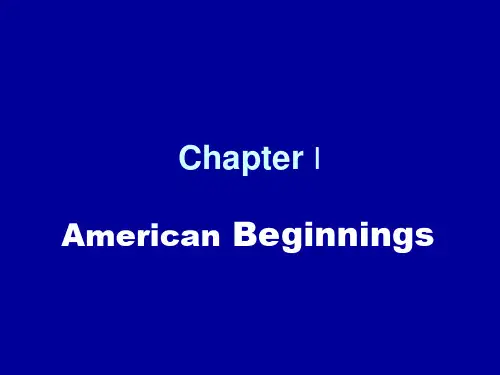
What is American?
A mixture of nationality Melting pot Salad bowl
How and why did the immigrants come to North America
• Immigrants • Immigration movements
The first colonies in America
• The Settlement in Virginia • Puritans in New England • Catholic Maryland • Quakers in Pennsylvania
Puritanism
• God and Man • Predestination • Work Ethics • Education
people natural rights natural law human law
“All men are naturally free and equal in the state of nature.” “Men living together according to reason without a common superior on earth, with no authority to judge between them, is properly the stated of nature.”
“The state of nature has a law of nature to govern it, which obliges everyone , and reason which is that law, teaches all mankind who will but consult it, that being all equal and independent, no one ought to harm another in his life, health, liberty or possessions.”
英美文化 (英国部分答案)
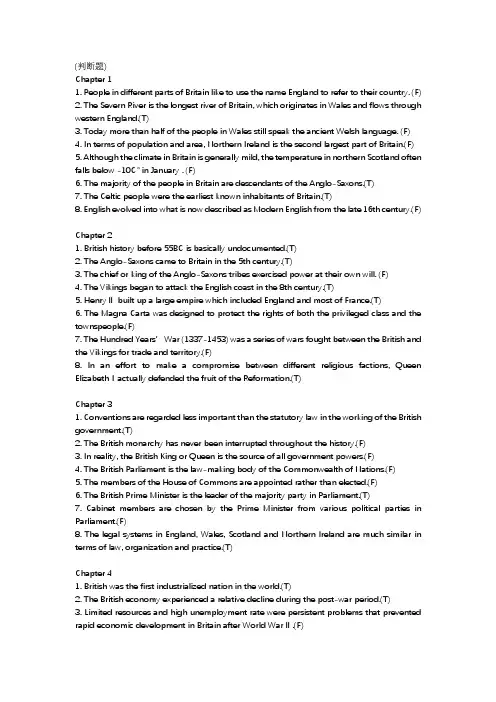
(判断题)Chapter 11. People in different parts of Britain like to use the name England to refer to their country. (F)2. The Severn River is the longest river of Britain, which originates in Wales and flows through western England.(T)3. Today more than half of the people in Wales still speak the ancient Welsh language. (F)4. In terms of population and area, Northern Ireland is the second largest part of Britain.(F)5. Although the climate in Britain is generally mild, the temperature in northern Scotland often falls below -10℃ in January . (F)6. The majority of the people in Britain are descendants of the Anglo-Saxons.(T)7. The Celtic people were the earliest known inhabitants of Britain.(T)8. English evolved into what is now described as Modern English from the late 16th century.(F)Chapter 21. British history before 55BC is basically undocumented.(T)2. The Anglo-Saxons came to Britain in the 5th century.(T)3. The chief or king of the Anglo-Saxons tribes exercised power at their own will. (F)4. The Vikings began to attack the English coast in the 8th century.(T)5. HenryⅡ built up a large empire which included England and most of France.(T)6. The Magna Carta was designed to protect the rights of both the privileged class and the townspeople.(F)7. The Hundred Years’War (1337-1453) was a series of wars fought between the British and the Vikings for trade and territory.(F)8. In an effort to make a compromise between different religious factions, Queen ElizabethⅠactually defended the fruit of the Reformation.(T)Chapter 31. Conventions are regarded less important than the statutory law in the working of the British government.(T)2. The British monarchy has never been interrupted throughout the history.(F)3. In reality, the British King or Queen is the source of all government powers.(F)4. The British Parliament is the law-making body of the Commonwealth of Nations.(F)5. The members of the House of Commons are appointed rather than elected.(F)6. The British Prime Minister is the leader of the majority party in Parliament.(T)7. Cabinet members are chosen by the Prime Minister from various political parties in Parliament.(F)8. The legal systems in England, Wales, Scotland and Northern Ireland are much similar in terms of law, organization and practice.(T)Chapter 41. British was the first industrialized nation in the world.(T)2. The British economy experienced a relative decline during the post-war period.(T)3. Limited resources and high unemployment rate were persistent problems that prevented rapid economic development in Britain after World WarⅡ.(F)4. Thatcher’s revolution turned out to be a great success i n dealing with all the British economic and social problems.(F)5. The economic approach adopted by Tony Blair was different from that of the old Labor Party and the Conservative Party.(T)6. Blair made the Bank of England independent in order to separate politics from economic policy.(T)7. Britain is an important oil exporter since its oil industry has a long history.(F)8. Nuclear power is one of the major energy source in Britain.(T)Chapter 51. The British government has been responsible for education since the early1800s.(F)2. Education in Britain is compulsory for all children between the ages of 6 and15.(F)3. The National Curriculum is compulsory in both the state system and theindependent system.(F)4. When children finish their schooling at 16, they are required to take a nationalGCSE examination.(T)5. Graduates from state schools in Britain have a less favorable chance to enterfamous universities than those from independent schools.(T)6. The Times is the world’s oldest Sunday newspapers.(F)7. The BBC World Service broadcasts only in English throughout the world.(F)(选择题)Chapter 11. The two main islands of the British Isles are .A. Great Britain and IrelandB. Great Britain and ScotlandC. Great Britain and WalesD. Great Britain and England2. is the capital city of Scotland.A. BelfastB. EdinburghC. AberdeenD. Cardiff3. Among the four parts of the United Kingdom, is the smallest.A. EnglandB. ScotlandC. WalesD. NorthernIreland4. English belongs to the group of Indo-European family of languages.A. CelticB. Indo-IranianC. GermanicD. Roman5. The introduction of Christianity to Britain added the first element ofwords to English.A. Danish and FinnishB. Dutch and GermanC. French and ItalianD. Latin and Greek6. The evolution of Middle English was reinforced by the influence.A. NormanB. DutchC. GermanD. Danish7. Samuel Johnson’s dictionary was influential in establishing a standard form of .A. grammarB. handwritingC. spellingD.pronunciation8. At present, nearly of the world’s population communicate in English.A. halfB. a quarterC. one thirdD. one fifthChapter 21. The attack on Rome ended the Roman occupation in Britain in 410.A. NormanB. DanishC. CelticD. Germanic2. By the late 7th century, became the dominant religion in England.A. Celtic ChristianityB. Anglo-Saxon ChristianityC. Germanic ChristianityD. Roman Christianity3. The marked the establishment of feudalism in England.A. Viking invasionB. signing of the Magna CartaC. Norman ConquestD. Adoption of common law4. The end of the Wars of the Roses led to the rule of .A. the House of ValoisB. the House of YorkC. the House of TudorD. the House of Lancaster5. The direct cause for the Religious Reformation was King Henry VIII’s effort to .A. divorce his wifeB. break with RomeC. support the ProtestantsD. declare his supreme power over the church6. The English Civil War broke out in 1642 between .A. Protestants and PuritansB. Royalists and ParliamentariansC. nobles and peasantsD. aristocrats and Christians7. was passed after the Glorious Revolution.A. Bill of RightsB. Act of SupremacyC. Provisions of OxfordD. Magna Carta8. The Industrial Revolution was accomplished in Britain by the middle of the century.A. 17thB. 18thC. 19thD. 20thChapter 31. The British government is characterized by a division of powers between three ofthe following branches with the exception of the .A. judiciaryB. legislatureC. monarchyD. executive2. The importance of the British monarchy can be seen in its effect on .A. passing the billsB. advising the governmentC. political partiesD. public attitude3. As a revising chamber, the House of Lords is expected to the House of commons.A. rivalB. complementC. criticizeD. inspect4. is at the center of the British political system.A. The CabinetB. The House of LordsC. The House of CommonsD. The Privy Council5. The main duty of the British Privy Council is to .A. make decisionsB. give adviceC. pass billsD. supervise the Cabinet6. Generally speaking, the British Parliament operates on a system.A. single-partyB. two-partyC. three-partyD. multi-party7. The policies of the Conservative Party are characterized by pragmatism and .A. government interventionB. nationalization of enterprisesC. social reformD. a belief in individualism8. In Britain, the parliamentary general election is held every years.A. threeB. fourC. fiveD. sixChapter 41. The in the early 1970s worsened an already stagnant economy inBritain.A. oil crisisB. high inflation ratesC. large importsD. unemployment problem2. Of the following practices, does not belong to Thatcher’s social welfare reform.A. reducing child benefitsB. shortening the unemployment benefits periodC. reducing the unemploymentD. lowering old age pensions3. The Blair government has been successful in all the following aspects except .A. limiting government spendingB. keeping inflation under controlC. reducing unemploymentD. reducing inequality4. Britain has devoted of its land area to agriculture.A. 54%B. 64%C. 74%D.84%5. Britain’s important fishing areas include all the following except .A. the North SeaB. the English ChannelC. The sea area around IrelandD. The sea area between Britain and Ireland6. Coal mining industry in Britain provides of the energy consumed in the country.A. 1/3B. 1/4C. 1/5D. 2/37. The car industry in Britain in mostly .A. foreign-ownedB. state-ownedC. joint-ventureD. privately-owned8. Of the following sectors in Britain, has experienced spectacular growth since the end of Word War II.A. agricultureB. energy industryC. service industryD. manufacturing industryChapter 51. In Britain, the division between grammar schools and vocational schools wereended by the introduction of comprehensive schools in the .A. 1930sB. 1940sC. 1950sD. 1960s2.Over of British children receive primary and secondary education through the independent system.A. 5%B. 6%C. 7%D. 8%3. Partially funded by central government grants, the British universities receive their remaining funds from all the following sources except .A. tuition feesB. loansC. donationsD. corporate contributions4. To be admitted to the Open University, one needA. some educational qualificationsB. no educational qualificationsC. General Certificate of Education-AdvancedD. General National Vocational Qualifications5. Among Britain’s quality press, the following newspapers are regarded as the “Big Three” with the exception of .A. The TimesB. The GuardianC. The ObserverD. The Daily Telegraph6. Life on Earth is a kind of program produced by the BBC and is popular among 500 million viewers worldwide.A. featureB. dramaC. documentaryD. soap opera7. is Britain’s top pay television provider.A. BSBB. SkyTVC. BBCD. BSkyB8. The following Christmas traditions are particularly British except .A. Trooping the ColorB. Queen’s Christmas messageC. Boxing DayD. Christmas pantomime(简答题)Chapter 11. Why do tourists from all over the world like to go to Scotland?A: because they like to enjoy the beautiful Scottishscenery, to drink the scotchwhisky and to see the Scotsmen wearing kilts and playing bagpipes.2. How many periods can the development of the English language be divided into and what are they?A:the development of English language be divided into three period :old English , middle English ,modern English .3. Why did English become more important after the Black Death?A: the laboring and merchant classes grew in economic and social important after the Black Death. So English also grew in importance compared to French .Chapter 21. What were some of Queen Victoria’s major achievements?A:the Queen Victoria’s major achievements in alm ost every aspect : she promoted further industrial revolution, the building of railways and the growing of trade and commerce. By the end of her reign , British had developed to an empire including a quarter of the global population and nearly a quarter of the world’s landmass.2. What were the two camps in Europe in world war I?A: The central powers which included Germany ,Austria-Hungary , the ottoman empire and Bulgaria and allied powers which were mainly comprised of France , the Russian empire ,and British empire , Italy and the united states.3. Why did Britain cooperate closely with the united states after world war II?A: because they were allied during the war and share the same worries about the former soviet union.Chapter 31. What the three functions of the house of commons?A: the three functionsare : to draft laws, to scrutinize, criticize and restrain the activities of the governmentpolicy.2. What kind of public image dose liberal democrats have in Britain?A:the liberal democrats is perceived as “middle” between the conservation and the labor party . it is comparatively flexible and pragmatic in its balance of the individual and the social . it emphasizes the need for a change in Britain’sconstitutional arrangements to make the government more democratic and accountable.3. Why are independent candidates unlikely to win in the general election ?A; Because even if they were elected, they would be powerless in parliament. Therefore , it is not possible for many people to vote for independent candidates.Chapter 41. What was the negative aspect of Thatcher’s reform in the early 1980s?A: its negative aspect was a rapid increase in unemployment .in 1982,the unemployment rate reached the level of the great depression years, with three million people out of work.2. What are the characteristics of Britain’s agriculture?A:britain’s agriculture is characterized by a small portion of the population engaged in agriculture activities with a high degree of mechanization. Although it employs a mere 1% of the country’s labor force , it meets around 60% of the national demands.3. What happened to Britain’s beef industry in the mid-1990s?A: Britain’s beef industry was hit badly by BSE, resulting in a ban on beef exports in 1996.Chapter 51. What used to be the major functions of grammar schools and vocational schools in Britain?The major functions of grammar schools were to train the most academically capable students and prepare them for university , whereas the major functions of vocational schools were to help less successful students to learn a trade.2. What kind of subjects do Britain comprehensive schools provide?Britain comprehensive schools provide a general education, offering both academic subjects like literature and science, and practical subjects like cooking and carpentry.3. In what ways do Britishuniversities enjoy complete academic freedom? Britishuniversities enjoy complete academic freedom because they can appoint their own staff, decide which students to admit, provide their own courses and award their own degrees.4. What role dose the media play in British leisure culture?The media play an essential role in British leisure culture since it helps to shape the public’s opinion, determine people’s moral and political orientation and consolidate or undermine the rule or a government.。
American Beginnings1 英美文化课件
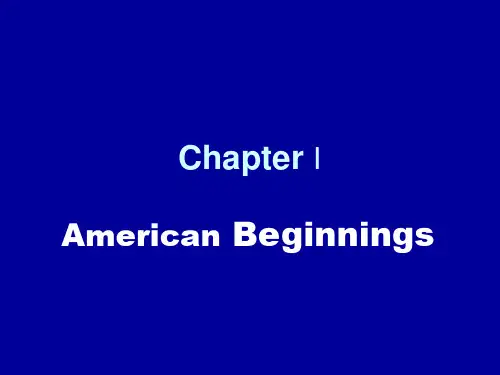
almighty a a man facing the evening sky --- nothing can stand between him and god . The Christian man must examine and judge for himself. ”
The Reformation
• The Reformation in England • Renaissance
Martin Luther
• Direct communication with God • All believers are priests • “the individual is as alone before the
• A 16th century religious movement as well as a socio-political movement.
• God has the absolute control over human kind
• Ceaseless work is a sign of salvation
people natural rights natural law human law
英美文化概况Chapter 1
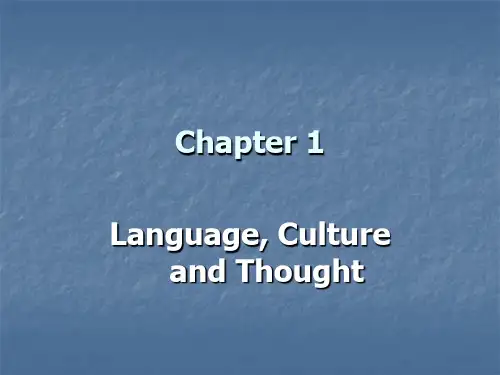
Intercultural Communication
A branch of communication It’s concerned with communication among It’ people from different cultural background. Originated in the U.S.
Systematic
A language is rule governed. People have to speak a language according to its rules.
Arbitrary
There is usually no logical relationship between words and the objects or concepts these words are used to refer to. Symbols are often chosen by convention. Some exceptions: Onomatopoeia, Compound words. (father-in-law, (father-ingreenhouse, playboy, school-bag) school-
Used to understand and describe the world(the second function) world(
Content words used to classify things. For instance, direction, time, quantity, quality, etc. Function words indicate the relationship between things. For instance, temporal(时间的) temporal(时间的) relations, a relation of locality, adversative(转折) adversative(转折) relation. Without language knowing and describing the world would never be possible.
英美文学选读(美国文学部分)
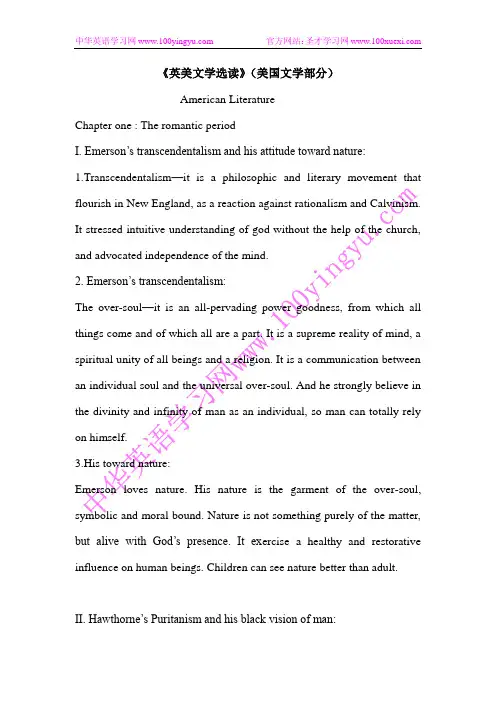
《英美文学选读》(美国文学部分)American LiteratureChapter one : The romantic periodI. Emerson’s transcendentalism and his attitude toward nature:1.Transcendentalism—it is a philosophic and literary movement that flourish in New England, as a reaction against rationalism and Calvinism. It stressed intuitive understanding of god without the help of the church, and advocated independence of the mind.2. Emerson’s transcendentalism:The over-soul—it is an all-pervading power goodness, from which all things come and of which all are a part. It is a supreme reality of mind, a spiritual unity of all beings and a religion. It is a communication between an individual soul and the universal over-soul. And he strongly believe in the divinity and infinity of man as an individual, so man can totally rely on himself.3.His toward nature:Emerson loves nature. His nature is the garment of the over-soul, symbolic and moral bound. Nature is not something purely of the matter, but alive with God’s presence. It ex ercise a healthy and restorative influence on human beings. Children can see nature better than adult.II. Hawthorne’s Puritanism and his black vision of man:1. Puritanism—it is the religious belief of the Puristans, who had intended to purify and simplify the religious ritual of the church of England.2. his black vision of man—by the Calvinistic concept of original sin, he believed that human being are evil natured and sinful, and this sin is ever present in human heart and will pass one generation to another.3. Young Goodman Brown—it shows that everyone has some evil secrets. The innocent and na?ve Brown is confronted with the vision of human evil in one terrible night, and then he becomes distrustful and doubtful. Brown stands for everyone ,who is born pure and has no contact with the real world ,and the prominent people of the village and church. They cover their secrets during daily lives, and under some circumstances such as the witch’s Sabbath, they become what they are. Even his closed wife, Faith, is no exception. So Brown is aged in that night.III. The symbolism of Melville’s Mobby-Dick1.The voyage to catch the white whale is the one of the mind in quest of the truth and knowledge of universe.2. To Ahab, the whale is an evil creature or the agent of an evil force that control the universe. As to readers, the whale is a symbol of physical limits, or a symbol of nature. It also can stand for the ultimate mystery of the universe and the wall behind which unknown malicious things are hiding.IV. Whitman and his Leaves of Grass :1. Theme: sing of the “en-mass” and the self / pursuit of love, happiness, and ***ual love / sometimes about politics (Drum taps)2. Whitman’s originality first in his use of the poetic form free verse (i.e. poetry without a fixed beat or regular rhyme scheme),by means of which he becomes conversational and casual.3.He uses the first person pronoun “I” to stress individualism, and oral language to acquire sympathy from the common reader.Chapter two : The realistic periodI. The character analysis and social meaning of Huck Finn in Adventure of Huckleberry Finn by Mark TwainHuck is a typical American boy with “a sound heart and a deformed conscience”. He appears to be vulgar in language and in manner, but he is honest and decent in essence. His remarkable raft’s journey down on the Mississippi river can be regarded as his process of education and his way to grow up. At first, he stands by slavery, for he clings to the idea that if he lets go the slave, he will be damned to go to hell. And when the “King” sells Jim for money, Huck decides to inform Jim’s master. After he thinks of the past good time when Jim and he are on the raft where Jim shows great care and deep affection for him, he decide to rescue Jim. AndHuck still thinks he is wrong while he is doing the right thing.Huck is the son of nature and a symbol for freedom and earthly pragmatism. Through the eye of Huck, the innocent and reluctant rebel, we see the pre-Civil War American society fully exposed. Twain contrasts the life on the river and the life on the banks, the innocence and the experience, the nature and the culture, the wilderness and the civilization.II. Daisy Miller by Henry James1. Theme: The novel is a story about American innocence defeated by the stiff, traditional values of Europe. James condemns the American failure to adopt expressive manners intelligently and point out the false believing that a good heart is readily visible to all. The death of Daisy results from the misunderstanding between people with different cultural backgrounds.2. The character analysis of Daisy: She represents typical American girl, who is uninformed and without the mature guidance. Ignorance and parental indulgence combine to foster he assertive self-confidence and fierce willfulness. She behaves in the same daring naive way in Europe as she does at home. When someone is against her, she becomes more contrary. She knows that she means no harm and is amazed that anyone should think she does. She does not compromise to the European manners.3. The character analysis of Winterbourne: He is a Europeanized American, who has live too long in foreign parts. He is very experience and has a problem understanding Daisy. He endeavors to put her in sort of formula, i.e. to classify her.III. Sister Carrie by Theodore Dreiser:1. Theme: The author invented the success of Carrie and the downfall of Hurstwood out of an inevitable and natural judgment, because the fittest can survive in a competitive, amoral society according to the social Darwinism.2. The character analysis of Carrie: She follows the right direction to a pursuit of the American dream, and the circumstances and her desire for a better life direct to the successful goal. But she is not contented, because with wealth and fame, she still finds herself lonely. She is a product of the society, a realization of the theory of the survival of the fittest.3. The character analysis of Hurstwood: He is a negative evidence of the theory of the survival of the fittest. Because he is still conventional and can not throw away the social morals, he is not fitted to live in New York.Chapter Three: The Modern PeriodI. Ezra Pound and his theory of Imagism1. The principles: a. direct treatment of the thing; b. to use absolutely noword that does not contribute to the presentation; c. to compose in the sequence of the musical; d. to use the language of common speech and the exact word; e. to create new rhythms; f. absolutely freedom in the choice of subject.2. Imagism is to present an intellectual and emotional complex in an instant of time. An imagistic poem must present the object exactly the way the thing is seen. And the reader can form the image of the object through the process of reading the abstract and concrete words.II. Frost and his poetry on nature:Frost is deeply interested in nature and in men’s relationship to nature. Nature appears as an explicator and a mediator for man and serve as the center of reference of his behavior. Peace and order can be found in Frost’s poetical natural world. With surface simplicity of his poems, the thematic concerns are always presented in rich symbols. Therefore his work resists easy interpretation.III. F. Scott Fitzgerald and his The Great Gatsby1. Theme: Gatsby is American Everyman. His extraordinary energy and wealth make him pursue the dream. His death in the end points at the truth about the withering of the American Dream. The spiritual and moral sterility that has resulted from the withered American Dream is fullyrevealed in the article. However, although he is defeated, the dream has gave Gatsby a dignity and a set of qualities. His hope and belief in the promise of future makes him the embodiment of the values of the incorruptible American Dream .2. The character analysis of Gatsby: Gatsby is great, because he is dignified and ennobled by his dream and his mythic vision of life. He has the desire to repeat the past, the desire for money, and the desire for incarnation of unutterable vision on this material earth. For Gatsby, Daisy is the soul of his dreams. He believe he can regain Daisy and romantically rebels of time. Although he has the wealth that can match with the leisured class, he does not have their manners. His tragedy lies in his possession of a naive sense and chivalry.IV. Ernest Hemingway’s artistic features:1. The Hemingway code heroes and grace under pressure:They have seen the cold world ,and for one cause, they boldly and courageously face the reality. They has an indestructible spirit for his optimistic view of life. Whatever is the result is, the are ready to live with grace under pressure. No matter how tragic the ending is, they will never be defeated. Finally, they will be prevail because of their indestructible spirit and courage.2. The iceberg technique:Hemingway believe that a good writer does not need to reveal every detail of a character or action. The one-eighth the is presented will suggest all other meaningful dimensions of the story. Thus, Hemingway’s language is symbolic and suggestive.V. The character analysis of Emily in A Rose for Emily:Emily is a symbol of old values, standing for tradition, duty and past glory. But she is also a victim to all those she cares and embrace. The source of Emily’s strange ness is from her born pride and self-esteem, the domineering behavior of her father and the betrayal of her lover. Barricaded in her house, she has frozen the past to protect her dreams. Her life is tragic because the defiance of the community, her refusal to accept the change and her extreme pride have pushed her to abnormality and insanity.。
新编英美文化 unit 1
7
Alternatives
However the issue of a replacement term remains unsettled as of 2003, though in the context of the Northern Ireland peace process the term "Islands of the North Atlantic" (IONA), a term initially created by former Conservative Party MP Sir John Biggs-Davison, has been used as a neutral term to describe these islands .
Unit 1 Background to Britain
1
Focal Questions
What is the full name of the British state? What countries does it consist of? What is the total population of the United Kingdom? Where do most people live?
2
3
4
Do you know the meaning of the following terms?
Celts Britain England Anglo-Saxons Indo-European language Germanic language Vikings Norman conquest
凯尔特人印欧民族的一支,最初分布在中欧,在 前罗马帝国时期遍及欧洲西部、不列颠群岛和加 拉提亚东南部。尤指不列颠人或高卢人
英美文化概论提纲
英美文化概论提纲Unit 1 a brief introduction to the united kingdom 1一 a brief introduction1.全称 The United Kingdom of Great Britain and northern Ireland--P17 III 12.构成England LondonScotland EdinburghWales CardiffNothern Ireland Belfast--P17 III23.历史A公元43世纪RomanB公元7世纪Anglo –saxons 安格鲁撒克逊人C 8世纪末阿尔弗雷德大帝King Alfred北欧海盗D 1066年诺曼征服NormansWilliam of NormandyBattle of HastingsKing Harold4.英国内战 civil war 资产阶级革命二Scotland1. Glasgow 最大城市 --P16 II 82. 大学15世纪 ancient and international university --P17 III 11三WalesUnlike England it did not fall to the Anglo-Saxon invaders of the 5th century --P16 II 11名词解释London:the largest city located in the south of the country .London is dominant in the UK in all fields;government finance and culture.London is one of the top three financial centers in the worldUnit 2 a brief introduction to the united kingdom iiNorthern Ireland1.宗教爱尔兰人是天主教徒 Catholics英国人是新教徒 Protestants--P33 I 62.1921年独立 Irish State (分水岭)3.爱尔兰南部26郡成立自由邦北部6 郡仍属英国—P34 II 104 .Loyalist 民族派希望加入爱尔兰共和国Unionist 联合派亲英国5.The official IRA 倾向于政治手段解决–P34 III 4The Provisional IRA 军事–P35 III 5“The Bullet and the Ballot Box”—P35 III 106.区分 Sinn Fein是政党 --P33 I 8/P35 III 11,121919 IRA是军事团体非政党7 .1973年 Power-Sharing mechanism权利分享机制—P34 II 88.1972 “Bloody Sunday”—P34 II 79.1985 Anglo-Irish agreement --P33 I 910. Downing –Street Declaration唐宁街宣言授权英军司令直接干预北爱治安事务名词解释1.”Home-rule”:1914年被签署成为法律。
英美国家文化概况(中英文对照)-美国 精品
美国文化概况Chapter 1 Population, race and ethnic groups第一章人口和种族1) Introduction①American is the third most populous country in the world, with 255.5 million people. It isa nation of immigrants. Immigration accounts for a major source of population growth. There are many racial and ethnic groups. Between 80% and 90% of immigration in the United States now is from Asian and Hispanic counties. The first immigrants in American history came from England and Netherlands. Population movements are common in America.美国是世界上的第三大人口国,总人口约2.555亿,仅次于中国和印度。
美国是一个移民大国,移民人口是其人口总数增长的重要原因。
美国的有着不同民族和种族的人口。
在目前美国移民人口中,80%-90%来自亚洲和西班牙语国家。
美国历史上最早的移民来自于英格兰和荷兰。
人口迁徙在美国十分普遍。
2) Black people and the Civil Rights Movement①blacks and slaveryThe largest of the racial and ethnic minorities in the U.S., which 12.1 per cent of the population; the first blacks were brought to North America as slaves in 1619.美国最大的少数人种是黑人,占人口的12.1%;1619年最早的人人作为奴隶被运至美国。
英美国家文化概况(中英文对照)-英国
英国文化概况Chapter 1 Land and People第一章英国的国土与人民Different Names for Britain and its Parts英国的不同名称及其各组成部分1. Geographical names: the British Isles, Great Britain and England.地理名称:不列颠群岛,大不列颠和英格兰。
2. Official name: the United Kingdom of Great Britain and Northern Ireland.官方正式名称:大不列颠及北爱尔兰联合王国。
3. The British Isles are made up of two large islands-Great Britain (the larger one) and Ireland, and hundreds of small ones.不列颠群岛由两个大岛—大不列颠岛(较大的一个)和爱尔兰岛,及成千上万个小岛组成。
4. Three political divisions on the island of Great Britain: England, Scotland and Wales. 大不列颠岛上有三个政治区:英格兰、苏格兰和威尔士。
(1) England is in the southern part of Great Britain. It is the largest, most populous section.英格兰位于大不列颠岛南部,是最大,人口最稠密的地区。
(2) Scotland is in the north of Great Britain. It has three natural zones (the Highlands in the north; the Central lowlands; the south Uplands) Capital: Edinburgh苏格兰位于大不列颠的北部。
- 1、下载文档前请自行甄别文档内容的完整性,平台不提供额外的编辑、内容补充、找答案等附加服务。
- 2、"仅部分预览"的文档,不可在线预览部分如存在完整性等问题,可反馈申请退款(可完整预览的文档不适用该条件!)。
- 3、如文档侵犯您的权益,请联系客服反馈,我们会尽快为您处理(人工客服工作时间:9:00-18:30)。
Who Are the British?
The Country and the People
1. Geographical Position of UK
Of the British Isles the Great Britain is the largest island, often shortened as Britain for the convenience’s sake.
for an equal status of Welsh language with English and expected more native language and culture in schools, the media and in public life.
The Welsh , like the Scots, fall into two groups: those sheep farmers from the mountainous regions of the north and those who live and work in the highly industrialized south which is notorious for low wages and awful living conditions of the coal miners. Two very different passions (hobbies) have emerged for the hard-working Welsh: rugby football and choral singing. (Refer to P.7)
5. Geographical features Maps A. The Highland Zone a. The Highlands of Scotland b. The Central Lowland (Middle Valley) of Scotland B. The Lowland Zone a. The Midlands of England b. The North Eastern Lowlands 6. People Although the United Kingdom covers only a small area of the earth’s surface, it represents people of many different origins and cultures. The present-day British people are a mixture of ethnic groups.
The people of English origin make up the majority of the nation, but there are also the Scottish people, the Irish people, the Welsh people, and some other minority groups. In spite of the historical background, today all the them are British since almost everyone’s ancestor had come to the British Isles from somewhere else. That’s the reason why the three terms, the English people, the British people, and Britons are interchangeable.
3. Divisions of Great Britain
Traditionally Great Britain is divided into three parts or countries: England in the south, Scotland in the north, and Wales in the southwest. Maps
7. Who are today’s Britons?
a. The Stone Age hunters and gatherers arrived in Britain as early as about 10,000 years ago. b. The Neolithic people (新石器时代) followed as settled agriculturalists who kept animals and made simple pottery. c. From around 2000BC to 1500BC, the Bronze Age, huge monuments henges were erected by the Stone Age people possibly for religious purposes. Stonehenge d. Celtic peoples arrived by the end of the Bronze Age, around 700 BC, with iron-working skill.
Characteristics of the Scots They are noted for being inventive, hardworking, serious-minded and cautious with money. A separate assembly was intended to give the Scots greater say in their affairs. But the results of the referendum held in 1979 frustrated this effort. Famous exports whisky Famous Scottish Writers Robert Burns (1759-1796) Sir Walter Scott (1771-1832) Robert Louis Stevenson (பைடு நூலகம்850-1894)
Maps of UK
7. The Scotts
Highlanders The Scots, particularly the Highlanders from the mountainous north, try to maintain their separate identity. The Picts(比克特人) and the Celts (凯尔特人) were their earliest known ancestors. The language (the Gaelic language ) still spoken in remote areas comes from the ancient language of the Celtic tribes. Lowlanders Most Scots known as Lowlanders are concentrating in the densely-populated town and cities of the southern Scotland for great job opportunities and industrialization.
8. The Welsh
The Welsh have been united with England since the 1535 Act of Union (联盟法). Like the Scotts they have a strong awareness of their cultural heritage and show great love to music and poetry. Like the Scotts, an intended Welsh assembly was not favored by most Welsh, though they struggled
The national characteristics of the Irish people portrayed in the literary works are being introspective dreamers and poets, argumentative and aggressive. The long and violent history of Ireland 1)The whole island was colonized by England in 1159 and the situation was worsened when the Irish refused to accept the Protestant Reformation. Their stubborn faith in Catholicism despite cruel persecutions by the English led to constant uprisings.
2. Names
The full name of the United Kingdom is the United Kingdom of Great Britain and Northern Ireland (U.K.).
It mainly consists of Great Britain and Northern Ireland.
4. Divisions of Ireland
The struggle for independence led to the establishment of the Republic of Ireland in 1927. The remaining part is Northern Ireland known as Ulster.
Outstanding Welsh writers are Dylan Thomas(1914-1953) , Gwyn Thomas and Richard Llewellyn.
